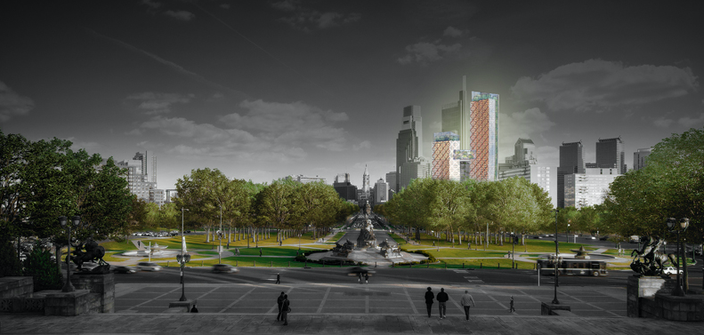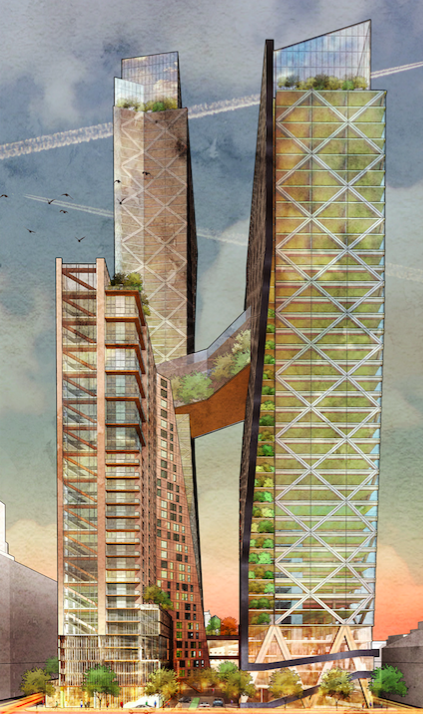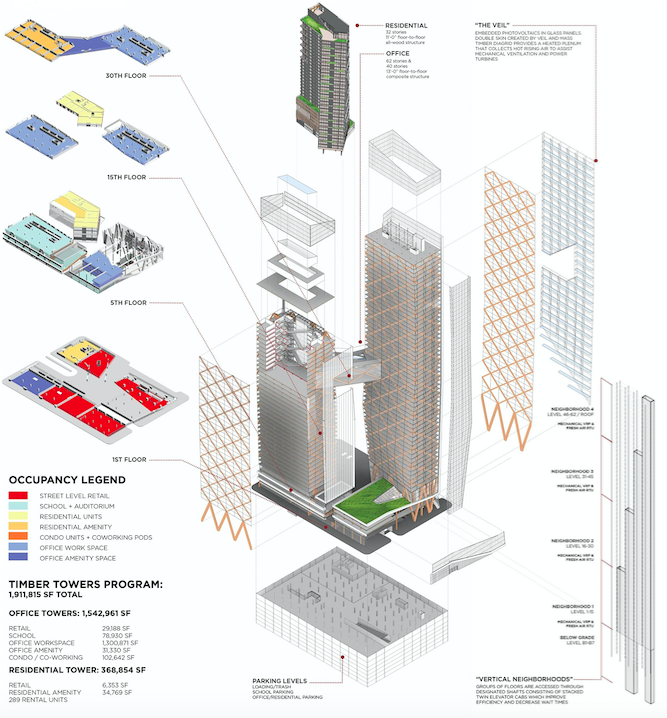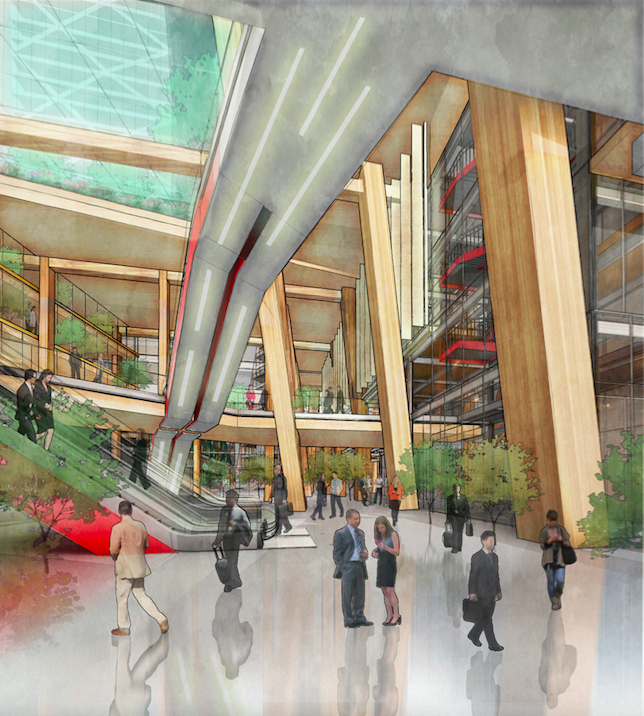
April 25, 2018
 Source/Hickok Cole Architects
Source/Hickok Cole Architects
Rendering of Timber Towers prototype, a project drawn up between Arch and Cherry Streets and 19th and 20th Streets.
Since the turn of the century, Philadelphia's skyline transformation has been led by the construction of not one, but two Comcast towers that now preside over the crowd in Center City.
If you peer west and 30 years into the future, city planners promise a drastically extended downtown that shimmers on both sides of the Schuylkill River.
Award-winning design plan surrounding Philadelphia's 30th Street Station.
But with increasing urgency to adopt more sustainable approaches to urban development, one Washington, D.C. architecture firm wants Philly to become a trailblazer in the future of high-rise construction.
Specifically, it wants Comcast to build its rumored third tower out of wood — mass timber, to be exact.
View of Timber Towers proposal from Ben Franklin Parkway.
McTaggart and his colleagues recently submitted their dazzling Timber Towers project to the Skyhive Skyscrapers Challenge, a conceptual design competition that encourages entrants to showcase their creativity within the realm of what can actually be achieved.
Mass timber isn't to be confused with the material you see in most cabins and cottages. It's an engineered product that uses cross-laminated panels as the primary load-bearing structure of a building, as opposed to accents or other design elements.
Enthusiasm for mass timber has picked up in recent years, particularly after the completion of Vancouver's 18-story Brock Commons at the University of British Columbia in 2016. Similar innovative structures have been built in Minneapolis, Amherst and elsewhere in Canada and Europe.
"Canada has really gotten behind mass timber," McTaggart said. "We're trying to build momentum in the United States through education. The concrete and steel industries are starting to recognize that we can disrupt their market."
The Timber Towers project was drawn up for a site between Arch and Cherry streets and 19th and 20th streets, where Comcast and Liberty Property Trust are believed to be weighing construction of a third high-rise.
At 62 stories, Timber Towers would be the first high-rise to utilize mass timber. Two office towers are linked by a connecting bridge, with a third tower including residences, a school and ground floor retail.
Rendering of Timber Towers.
There are several advantages to using mass timber, which continually removes carbon dioxide from the atmosphere.
"It sounds counterintuitive from a sustainability perspective to be cutting down more trees, but wood is the only construction material on earth that's truly renewable," McTaggart said.
The Forest Stewardship Council (FSC), for example, maintains standards for chain-of-custody certification that ensure mass timber products are harvested with a favorable balance toward woodland growth.
McTaggart sees states in the eastern United States as prime locations for the development of mass timber construction.
"Most forests on the West Coast in states like Washington and Oregon are government-owned," McTaggart said. The vast majority of privately owned forests are on the East Coast and in Canada."
Timber Towers program.
"You're pretty much using a power drill to build these structures," McTaggart said. "I believe the structural solution for the future will be some type of hybrid of materials that emphasizes mass timber."
Rendering of office interior at Timber Towers.
MacTaggart and his colleagues cite studies showing that cross-laminated timber has performed better on some fire tests than steel and concrete, forming an outer layer of char that insulates interior support structures. Experts have explored various strategies to strengthen fire resistance and safety in mass timber buildings.
Places like Baltimore have been hostile to McTaggart's outreach efforts, while Washington, D.C. has shown more receptiveness.
The team at Hickok Cole selected Philadelphia because the nation's capital has a height limit of 130 feet for skyscrapers. Philly was the closest city that would be economically viable for such a project. They also identified Comcast as a perfect suitor.
"A tech company like Comcast would be an ideal tenant to showcase this type of forward-thinking construction," McTaggart said.
Philadelphia appears to be somewhere between curious and indifferent at the moment. McTaggart said his team has been working to establish connections with Liberty Property Trust to discuss the Timber Towers proposal, but no formal meeting has taken place just yet.
"The goal right now is to educate the public and city leaders about mass timber," McTaggart said. "It makes sense for mid-rise and high-rise buildings. I think it will be a couple more years of educating."
 Source/30TH STREET STATION DISTRICT PLAN
Source/30TH STREET STATION DISTRICT PLAN Source/Hickok Cole Architects
Source/Hickok Cole Architects Source/Hickok Cole Architects
Source/Hickok Cole Architects Source/Hickok Cole Architects
Source/Hickok Cole Architects Source/Hickok Cole Architects
Source/Hickok Cole Architects